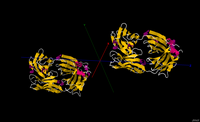
Photo from wikipedia
EGFR inhibitors used in the treatment of metastatic wild-RAS colorectal cancer in combination with chemotherapy are associated with dermatologic side events that are low grade in most cases. We report… Click to show full abstract
EGFR inhibitors used in the treatment of metastatic wild-RAS colorectal cancer in combination with chemotherapy are associated with dermatologic side events that are low grade in most cases. We report a case of severe cutaneous toxicity secondary to cetuximab associated with bacterial cellulitis. A 57-year-old woman with metastatic adenocarcinoma of the colon, receiving FOLFIRI and Cetuximab as a first-line treatment, presented with a severe erythematous rash and xerosis resistant to local treatment with moisturizing emollients. Few days later, the patient becomes febrile, and the rash becomes more diffuse with a sandpaper appearance on the face, neck, chest, and flexor creases with exfoliation of large areas of skin. A bacterial cellulitis secondary to a dermatologic severe toxicity of Cetuximab was suspected. The patient started on antibiotics and local treatment with good response. This is a life-threatening cutaneous toxicity of cetuximab with secondary bacterial infection. Early recognition of cutaneous side effects of EGFR inhibitors is important to prevent such type of toxicities.
Journal Title: Anti-cancer drugs
Year Published: 2022
Link to full text (if available)
Share on Social Media: Sign Up to like & get
recommendations!